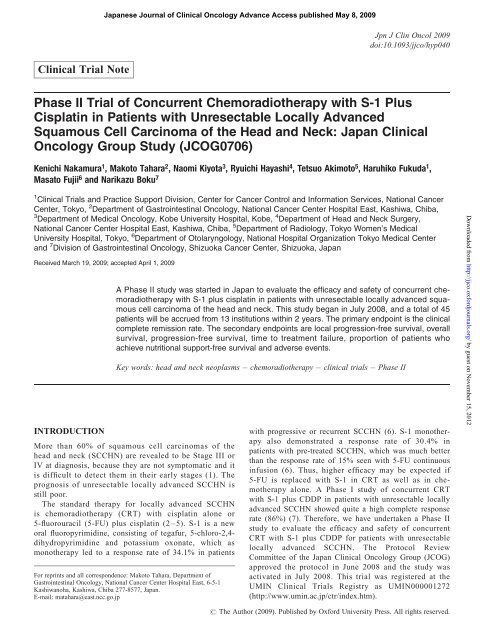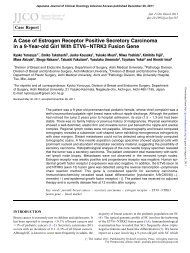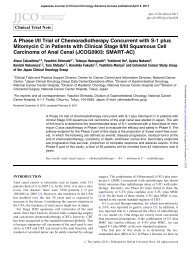Phase II Trial of Concurrent Chemoradiotherapy with S-1 Plus ...
Phase II Trial of Concurrent Chemoradiotherapy with S-1 Plus ...
Phase II Trial of Concurrent Chemoradiotherapy with S-1 Plus ...
You also want an ePaper? Increase the reach of your titles
YUMPU automatically turns print PDFs into web optimized ePapers that Google loves.
Clinical <strong>Trial</strong> Note<br />
Japanese Journal <strong>of</strong> Clinical Oncology Advance Access published May 8, 2009<br />
<strong>Phase</strong> <strong>II</strong> <strong>Trial</strong> <strong>of</strong> <strong>Concurrent</strong> <strong>Chemoradiotherapy</strong> <strong>with</strong> S-1 <strong>Plus</strong><br />
Cisplatin in Patients <strong>with</strong> Unresectable Locally Advanced<br />
Squamous Cell Carcinoma <strong>of</strong> the Head and Neck: Japan Clinical<br />
Oncology Group Study (JCOG0706)<br />
Kenichi Nakamura 1 , Makoto Tahara 2 , Naomi Kiyota 3 , Ryuichi Hayashi 4 , Tetsuo Akimoto 5 , Haruhiko Fukuda 1 ,<br />
Masato Fujii 6 and Narikazu Boku 7<br />
1 Clinical <strong>Trial</strong>s and Practice Support Division, Center for Cancer Control and Information Services, National Cancer<br />
Center, Tokyo, 2 Department <strong>of</strong> Gastrointestinal Oncology, National Cancer Center Hospital East, Kashiwa, Chiba,<br />
3 Department <strong>of</strong> Medical Oncology, Kobe University Hospital, Kobe, 4 Department <strong>of</strong> Head and Neck Surgery,<br />
National Cancer Center Hospital East, Kashiwa, Chiba, 5 Department <strong>of</strong> Radiology, Tokyo Women’s Medical<br />
University Hospital, Tokyo, 6 Department <strong>of</strong> Otolaryngology, National Hospital Organization Tokyo Medical Center<br />
and 7 Division <strong>of</strong> Gastrointestinal Oncology, Shizuoka Cancer Center, Shizuoka, Japan<br />
Received March 19, 2009; accepted April 1, 2009<br />
A <strong>Phase</strong> <strong>II</strong> study was started in Japan to evaluate the efficacy and safety <strong>of</strong> concurrent chemoradiotherapy<br />
<strong>with</strong> S-1 plus cisplatin in patients <strong>with</strong> unresectable locally advanced squamous<br />
cell carcinoma <strong>of</strong> the head and neck. This study began in July 2008, and a total <strong>of</strong> 45<br />
patients will be accrued from 13 institutions <strong>with</strong>in 2 years. The primary endpoint is the clinical<br />
complete remission rate. The secondary endpoints are local progression-free survival, overall<br />
survival, progression-free survival, time to treatment failure, proportion <strong>of</strong> patients who<br />
achieve nutritional support-free survival and adverse events.<br />
Key words: head and neck neoplasms – chemoradiotherapy – clinical trials – <strong>Phase</strong> <strong>II</strong><br />
INTRODUCTION<br />
More than 60% <strong>of</strong> squamous cell carcinomas <strong>of</strong> the<br />
head and neck (SCCHN) are revealed to be Stage <strong>II</strong>I or<br />
IV at diagnosis, because they are not symptomatic and it<br />
is difficult to detect them in their early stages (1). The<br />
prognosis <strong>of</strong> unresectable locally advanced SCCHN is<br />
still poor.<br />
The standard therapy for locally advanced SCCHN<br />
is chemoradiotherapy (CRT) <strong>with</strong> cisplatin alone or<br />
5-fluorouracil (5-FU) plus cisplatin (2–5). S-1 is a new<br />
oral fluoropyrimidine, consisting <strong>of</strong> tegafur, 5-chloro-2,4dihydropyrimidine<br />
and potassium oxonate, which as<br />
monotherapy led to a response rate <strong>of</strong> 34.1% in patients<br />
For reprints and all correspondence: Makoto Tahara, Department <strong>of</strong><br />
Gastrointestinal Oncology, National Cancer Center Hospital East, 6-5-1<br />
Kashiwanoha, Kashiwa, Chiba 277-8577, Japan.<br />
E-mail: matahara@east.ncc.go.jp<br />
Jpn J Clin Oncol 2009<br />
doi:10.1093/jjco/hyp040<br />
<strong>with</strong> progressive or recurrent SCCHN (6). S-1 monotherapy<br />
also demonstrated a response rate <strong>of</strong> 30.4% in<br />
patients <strong>with</strong> pre-treated SCCHN, which was much better<br />
than the response rate <strong>of</strong> 15% seen <strong>with</strong> 5-FU continuous<br />
infusion (6). Thus, higher efficacy may be expected if<br />
5-FU is replaced <strong>with</strong> S-1 in CRT as well as in chemotherapy<br />
alone. A <strong>Phase</strong> I study <strong>of</strong> concurrent CRT<br />
<strong>with</strong> S-1 plus CDDP in patients <strong>with</strong> unresectable locally<br />
advanced SCCHN showed quite a high complete response<br />
rate (86%) (7). Therefore, we have undertaken a <strong>Phase</strong> <strong>II</strong><br />
study to evaluate the efficacy and safety <strong>of</strong> concurrent<br />
CRT <strong>with</strong> S-1 plus CDDP for patients <strong>with</strong> unresectable<br />
locally advanced SCCHN. The Protocol Review<br />
Committee <strong>of</strong> the Japan Clinical Oncology Group (JCOG)<br />
approved the protocol in June 2008 and the study was<br />
activated in July 2008. This trial was registered at the<br />
UMIN Clinical <strong>Trial</strong>s Registry as UMIN000001272<br />
(http://www.umin.ac.jp/ctr/index.htm).<br />
# The Author (2009). Published by Oxford University Press. All rights reserved.<br />
Downloaded from<br />
http://jjco.oxfordjournals.org/ by guest on November 15, 2012
Page 2 <strong>of</strong> 4 <strong>Phase</strong> <strong>II</strong> trial <strong>of</strong> CRT for advanced head and neck cancer<br />
PROTOCOL DIGEST OF THE JCOG0706<br />
PURPOSE<br />
The aim <strong>of</strong> this study is to evaluate the efficacy and safety <strong>of</strong><br />
concurrent CRT <strong>with</strong> S-1 plus cisplatin in patients <strong>with</strong> unresectable<br />
locally advanced SCCHN.<br />
STUDY SETTING<br />
The study is a multi-institutional <strong>Phase</strong> <strong>II</strong> study.<br />
RESOURCES<br />
The study is supported by Grants-in-Aid for Cancer<br />
Research (18-19, 20S-3, 20S-6) from the Ministry <strong>of</strong> Health,<br />
Labour and Welfare <strong>of</strong> Japan.<br />
ENDPOINTS<br />
The primary endpoint is the clinical complete remission rate,<br />
which is the proportion <strong>of</strong> complete response (CR) and good<br />
partial response (good PR) in all eligible patients. Good PR<br />
is defined as a remaining secondary change <strong>with</strong> tumor<br />
shrinkage such that the remaining tissue is not regarded as<br />
residual tumor but rather as scar material. Our evaluative<br />
guidelines suggested identifying good PR lesions as 10 mm<br />
or less in size and not enhanced on contrasted computed tomography<br />
scan. The secondary endpoints are local progressionfree<br />
survival, progression-free survival, overall survival, time<br />
to treatment failure, proportion <strong>of</strong> patients achieving nutritional<br />
support-free survival and adverse events.<br />
Local progression-free survival is the time from enrollment<br />
to local disease progression or death from any cause.<br />
Progression-free survival is defined as the time from enrollment<br />
to any disease progression or death from any cause. Overall<br />
survival is defined as days from enrollment to death from any<br />
cause. Time to treatment failure is defined as the time from<br />
enrollment to any disease progression, <strong>of</strong>f-protocol treatment<br />
or death from any cause. Proportion <strong>of</strong> nutritional support-free<br />
survival denotes the percentage <strong>of</strong> surviving patients not<br />
requiring any nutritional support at the time <strong>of</strong> treatment start<br />
and then 2, 6, 12 and 24 months after registration.<br />
ELIGIBILITY CRITERIA<br />
INCLUSION CRITERIA<br />
For inclusion in the study, the patient must fulfill all <strong>of</strong> the<br />
following criteria: (i) histologically proven squamous cell<br />
carcinoma; (ii) primary lesion located at oropharynx, hypopharynx<br />
or larynx; (iii) unresectable locally advanced head<br />
and neck cancer which fulfills at least one <strong>of</strong> the following<br />
conditions: (a) primary lesion or cervical lymph node metastasis<br />
to carotid artery, cranial base or cervical vertebrae; (b)<br />
cervical lymph node metastasis <strong>of</strong> N2c or N3 (UICC/TNM,<br />
6th edition); and (c) T4 primary lesion located at<br />
oropharynx; (iv) no fistula due to primary lesion or cervical<br />
lymph node metastasis; (v) no distant metastasis; (vi) age<br />
between 20 and 75 years old; (vii) ECOG performance status<br />
<strong>of</strong> 0 or 1; (viii) no prior radical surgery for head and neck<br />
cancer; (ix) no prior treatment for any other malignancies<br />
<strong>with</strong> chemotherapy, radiation therapy or endocrine therapy;<br />
(x) sufficient organ function; (xi) normal electrocardiogram;<br />
and (xii) written informed consent.<br />
EXCLUSION CRITERIA<br />
Patients are excluded if they meet any <strong>of</strong> the following criteria:<br />
(i) active bacterial or fungous infection; (ii) simultaneous<br />
or metachronous (<strong>with</strong>in 5 years) double cancers<br />
except carcinoma in situ or intramucosal tumor; (iii) women<br />
during pregnancy or breastfeeding; (iv) active gastrointestinal<br />
bleeding; (v) pleural effusion, pericardial effusion or<br />
massive ascites; (vi) history <strong>of</strong> severe heart disease, heart<br />
failure, myocardial infarction <strong>with</strong>in 6 months or angina pectoris<br />
attack <strong>with</strong>in 6 months; (vii) cerebrovascular disease<br />
<strong>with</strong>in 6 months; (viii) diabetes mellitus treated <strong>with</strong> insulin<br />
or poorly controlled; (ix) poorly controlled hypertension; (x)<br />
chronic pancreatitis; (xi) positive HBs antigen; (xii) impossibility<br />
to refrain from smoking and drinking during treatment;<br />
and (xiii) requiring systemic steroids medication.<br />
TREATMENT METHODS<br />
The protocol treatment consists <strong>of</strong> concurrent CRT, adjuvant<br />
chemotherapy and salvage surgery if necessary (Fig. 1).<br />
First, patients receive concurrent CRT <strong>with</strong> S-1 plus cisplatin.<br />
S-1 (60 mg/m 2 /day) is orally administered for two<br />
weeks and cisplatin is infused on days 8 through 11, repeated<br />
every five weeks for two courses.<br />
Radiation therapy is administered <strong>with</strong> high-energy<br />
photons <strong>of</strong> 4–10 MV X-rays to a total dose <strong>of</strong> 70 Gy in a<br />
fraction <strong>of</strong> 2 Gy five times weekly. The gross tumor volume<br />
(GTV) includes the volumes <strong>of</strong> both the primary tumor and<br />
metastatic cervical lymph nodes <strong>with</strong> a short axis <strong>of</strong> 1 cm or<br />
larger. The clinical target volume 1 (CTV1) includes GTV<br />
and bilateral regional cervical lymph node area <strong>with</strong> a<br />
1–2 cm margin, and CTV2 includes GTV <strong>with</strong> a 0.5–2 cm<br />
margin. The planning target volumes (PTVs) for CTV1 and<br />
CTV2 (PTV1 and PTV2) are defined as 0.5–1 cm margins<br />
around CTV to compensate for set-up variations and internal<br />
organ motion. A total <strong>of</strong> 40 Gy is delivered toward PTV1,<br />
and then an additional 30 Gy is boosted to PTV2.<br />
For patients <strong>with</strong> an objective response (CR, good PR or<br />
PR) at the first evaluation after CRT, adjuvant chemotherapy<br />
<strong>with</strong> S-1 plus cisplatin is administered for two more courses.<br />
In adjuvant chemotherapy, S-1 (60 mg/m 2 /day) is orally<br />
administered for 2 weeks and cisplatin (20 mg/m 2 /day) is<br />
infused on days 8 through 11, repeated every 4 weeks. At the<br />
second evaluation after adjuvant chemotherapy, patients diagnosed<br />
<strong>with</strong> CR or good PR are regarded as having completed<br />
the protocol treatment. Patients not diagnosed <strong>with</strong> CR or<br />
Downloaded from<br />
http://jjco.oxfordjournals.org/ by guest on November 15, 2012
Figure 1. Schema <strong>of</strong> the study. SCCHN, squamous cell carcinoma <strong>of</strong> head<br />
and neck; PS, performance status; CDDP, cisplatin; RT, radiation; CR, complete<br />
response; PR, partial response; SD, stable disease; PD, progressive<br />
disease.<br />
good PR are discontinued from treatment, and salvage<br />
surgery is planned if it is judged to be clinically feasible.<br />
FOLLOW-UP<br />
All enrolled patients are followed up for at least 3 years.<br />
Efficacy and safety are to be evaluated at least every 3<br />
months during the first year, at least every 4 months during<br />
the second year and then every 6 months during the third<br />
year. Data on the use and methodology <strong>of</strong> nutritional support<br />
are reported at 2, 6, 12 and 24 months after registration.<br />
STUDY DESIGN AND STATISTICAL ANALYSIS<br />
This trial is designed to evaluate the efficacy and safety <strong>of</strong><br />
CRT <strong>with</strong> S-1 plus cisplatin and to determine the viability <strong>of</strong><br />
proceeding to a <strong>Phase</strong> <strong>II</strong>I trial. In this <strong>Phase</strong> <strong>II</strong> trial, the<br />
planned sample size is 45 patients, which was calculated by<br />
SWOG’s (Southwest Oncology Group) two-stage attained<br />
design (8) based on an expected clinical complete remission<br />
rate <strong>of</strong> 60% and a threshold <strong>of</strong> 45%, <strong>with</strong> a one-sided<br />
a error <strong>of</strong> 0.1 and a b error <strong>of</strong> 0.1. If at least 10 clinical<br />
complete remissions occur after the first 25 patients enroll,<br />
another 20 patients will be accrued.<br />
If the clinical complete remission rate is as high as<br />
expected, the subsequent <strong>Phase</strong> <strong>II</strong>I trial will be designed to<br />
confirm the superiority <strong>of</strong> CRT <strong>with</strong> S-1 plus cisplatin to<br />
CRT <strong>with</strong> cisplatin alone.<br />
INTERIM ANALYSIS AND MONITORING<br />
In this <strong>Phase</strong> <strong>II</strong> trial, an interim analysis is planned once,<br />
which corresponds to the first-stage analysis in the two-stage<br />
design. The Data and Safety Monitoring Committee<br />
(DSMC) <strong>of</strong> the JCOG will independently review the interim<br />
analysis reports and recommend that the trial either be continued<br />
or terminated early. Central monitoring will be performed<br />
every 6 months by the Data Center to evaluate and<br />
improve study progress and quality.<br />
PARTICIPATING INSTITUTIONS (FROM NORTH TO SOUTH)<br />
Hokkaido University Hospital, Miyagi Cancer Center,<br />
Yamagata Prefectural Central Hospital, Jichi Medical University<br />
Hospital, National Cancer Center Hospital East, Tokyo<br />
Women’s Medical University Hospital, National Hospital<br />
Organization Tokyo Medical Center, Kanagawa Cancer Center,<br />
Shizuoka Cancer Center, Aichi Cancer Center, Kobe University<br />
Hospital, Hyogo Cancer Center and Shikoku Cancer Center.<br />
Funding<br />
This work is supported by Grant-in-Aid for Cancer Research<br />
(18-19, 20S-3, 20S-6) from the Ministry <strong>of</strong> Health, Labour<br />
and Welfare <strong>of</strong> Japan.<br />
Conflict <strong>of</strong> interest statement<br />
None declared.<br />
References<br />
Jpn J Clin Oncol 2009 Page 3 <strong>of</strong> 4<br />
1. Forastiere AA, Ang KK, Brizel D, Brockstein BE,<br />
Burtness BA, Cmelak AJ, et al. Head and neck cancers. National<br />
Comprehensive Cancer Network. Clinical Practice Guidelines in<br />
Oncology. v.2.2008.<br />
2. Adelstein DJ, Li Y, Adams GL, Wagner H, Jr, Kish JA, Ensley JF, et al.<br />
An intergroup phase <strong>II</strong>I comparison <strong>of</strong> standard radiation therapy and<br />
two schedules <strong>of</strong> concurrent chemoradiotherapy in patients <strong>with</strong><br />
unresectable squamous cell head and neck cancer. J Clin Oncol<br />
2003;21:92–8.<br />
3. Brizel DM, Albers ME, Fisher SR, Scher RL, Richtsmeier WJ, Hars V,<br />
et al. Hyperfractionated irradiation <strong>with</strong> or <strong>with</strong>out concurrent<br />
Downloaded from<br />
http://jjco.oxfordjournals.org/ by guest on November 15, 2012
Page 4 <strong>of</strong> 4 <strong>Phase</strong> <strong>II</strong> trial <strong>of</strong> CRT for advanced head and neck cancer<br />
chemotherapy for locally advanced head and neck cancer. N Engl J Med<br />
1998;338:1798–804.<br />
4. Browman GP, Hodson DI, Mackenzie RJ, Bestic N, Zuraw L. Choosing a<br />
concomitant chemotherapy and radiotherapy regimen for squamous cell<br />
head and neck cancer: a systematic review <strong>of</strong> the published literature<br />
<strong>with</strong> subgroup analysis. Head Neck 2001;23:579–89.<br />
5. Merlano M, Corvo R, Margarino G, Benasso M, Rosso R, Sertoli MR,<br />
et al. Combined chemotherapy and radiation therapy in advanced<br />
inoperable squamous cell carcinoma <strong>of</strong> the head and neck. The final<br />
report <strong>of</strong> a randomized trial. Cancer 1991;67:915–21.<br />
6. Inuyama Y, Kida A, Tsukuda M, Kohno N, Satake B. Late phase <strong>II</strong> study<br />
<strong>of</strong> S-1 in patients <strong>with</strong> advanced head and neck cancer. Gan To Kagaku<br />
Ryoho 2001;28:1381–90.<br />
7. Tahara M, Minami H, Mukai H, Kawada K, Kawashima M, Ogino T,<br />
et al. <strong>Phase</strong> I trial <strong>of</strong> concurrent chemoradiotherapy <strong>with</strong> S-1 and CDDP<br />
in patients <strong>with</strong> unresectable locally advanced squamous cell carcinoma<br />
<strong>of</strong> the head and neck (SCCHN). American Society <strong>of</strong> Clinical Oncology<br />
(ASCO) Anuual Meeting; 2005. p. 518s.<br />
8. Green SJ, Dahlberg S. Planned versus attained design in phase <strong>II</strong> clinical<br />
trials. Stat Med 1992;11:853–62.<br />
Downloaded from<br />
http://jjco.oxfordjournals.org/ by guest on November 15, 2012







